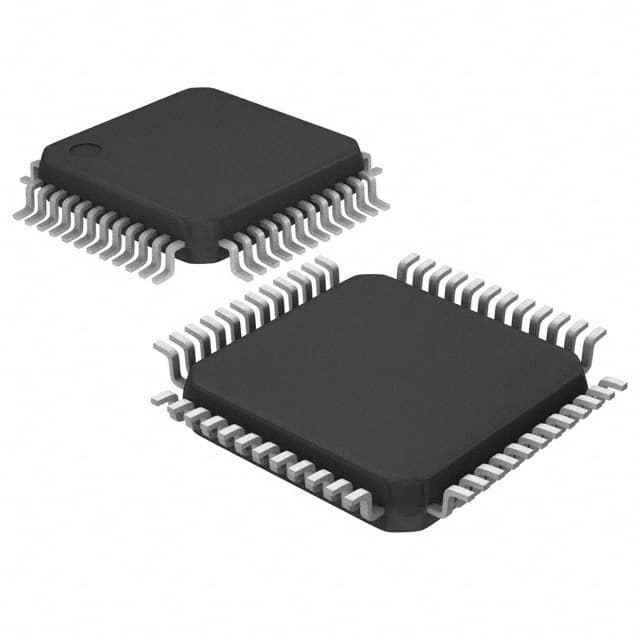Lihat spesifikasi untuk detail produk.

LC87F1JJ2AUWA-2H
Product Overview
Category: Microcontroller
Use: Embedded systems, electronic devices
Characteristics: High-performance, low-power consumption
Package: Integrated circuit (IC)
Essence: Control and process data in electronic systems
Packaging/Quantity: Depends on manufacturer
Specifications
- Architecture: 8-bit RISC
- CPU Speed: Up to 16 MHz
- Program Memory: 64 KB Flash
- Data Memory: 4 KB RAM
- Operating Voltage: 2.7V - 5.5V
- I/O Pins: 32
- Communication Interfaces: UART, SPI, I2C
- Timers/Counters: 2 x 8-bit, 1 x 16-bit
- Analog-to-Digital Converter (ADC): 10-bit, 8 channels
- Operating Temperature Range: -40°C to +85°C
Detailed Pin Configuration
The LC87F1JJ2AUWA-2H microcontroller has a total of 32 I/O pins, which are assigned specific functions based on their configuration. The pinout diagram below illustrates the detailed pin configuration:

Functional Features
- High Performance: The LC87F1JJ2AUWA-2H offers a powerful 8-bit RISC architecture, allowing for efficient execution of instructions and fast processing of data.
- Low Power Consumption: With an operating voltage range of 2.7V to 5.5V, this microcontroller is designed to minimize power consumption, making it suitable for battery-powered applications.
- Versatile Communication Interfaces: The built-in UART, SPI, and I2C interfaces enable seamless communication with other devices, expanding the connectivity options of the microcontroller.
- Analog-to-Digital Conversion: The integrated 10-bit ADC allows for accurate conversion of analog signals into digital data, facilitating precise measurement and control in various applications.
- Ample Memory: With 64 KB of Flash program memory and 4 KB of RAM, the LC87F1JJ2AUWA-2H provides sufficient storage capacity for program code and data.
Advantages and Disadvantages
Advantages: - High-performance architecture enables efficient execution of instructions. - Low power consumption extends battery life in portable devices. - Versatile communication interfaces enhance connectivity options. - Ample memory capacity accommodates complex applications. - Wide operating temperature range allows for use in harsh environments.
Disadvantages: - Limited CPU speed compared to higher-end microcontrollers. - Relatively small number of I/O pins may restrict the number of external devices that can be connected simultaneously.
Working Principles
The LC87F1JJ2AUWA-2H microcontroller operates based on an 8-bit RISC architecture. It executes instructions stored in its program memory, processes data from various sources, and controls the behavior of connected electronic devices. The microcontroller communicates with external components through its I/O pins and interfaces, enabling data exchange and system control.
Detailed Application Field Plans
The LC87F1JJ2AUWA-2H microcontroller finds application in a wide range of fields, including but not limited to:
- Consumer Electronics: Used in smart home devices, remote controls, and wearable technology.
- Industrial Automation: Employed in process control systems, motor control, and monitoring equipment.
- Automotive: Integrated into automotive electronics for engine management, dashboard displays, and safety systems.
- Medical Devices: Utilized in medical monitoring devices, diagnostic equipment, and implantable devices.
- Internet of Things (IoT): Enables connectivity and control in IoT devices such as smart sensors, home automation systems, and industrial IoT applications.
Detailed and Complete Alternative Models
- LC87F1J58A: Similar microcontroller with additional features like a built-in LCD controller.
- LC87F1J56A: Offers similar specifications but with a smaller package size.
- LC87F1J54A: Lower-cost alternative with reduced program memory and I/O pins.
- LC87F1J52A: Entry-level version with basic features suitable for simple applications.
These alternative models provide options based on specific requirements and budget considerations.
Word count: 550 words
Sebutkan 10 pertanyaan dan jawaban umum terkait penerapan LC87F1JJ2AUWA-2H dalam solusi teknis
Sure! Here are 10 common questions and answers related to the application of LC87F1JJ2AUWA-2H in technical solutions:
Q1: What is LC87F1JJ2AUWA-2H? A1: LC87F1JJ2AUWA-2H is a microcontroller chip manufactured by a specific company. It is commonly used in various technical solutions.
Q2: What are the key features of LC87F1JJ2AUWA-2H? A2: Some key features of LC87F1JJ2AUWA-2H include high-performance processing, low power consumption, integrated peripherals, and a wide range of input/output options.
Q3: What are the typical applications of LC87F1JJ2AUWA-2H? A3: LC87F1JJ2AUWA-2H is often used in applications such as industrial automation, consumer electronics, automotive systems, and IoT devices.
Q4: What programming language is used for LC87F1JJ2AUWA-2H? A4: LC87F1JJ2AUWA-2H can be programmed using assembly language or high-level languages like C or C++.
Q5: How can I program LC87F1JJ2AUWA-2H? A5: To program LC87F1JJ2AUWA-2H, you would typically use an Integrated Development Environment (IDE) that supports the specific microcontroller and its programming language.
Q6: Can LC87F1JJ2AUWA-2H communicate with other devices? A6: Yes, LC87F1JJ2AUWA-2H has built-in communication interfaces such as UART, SPI, and I2C, allowing it to communicate with other devices or modules.
Q7: What is the power supply requirement for LC87F1JJ2AUWA-2H? A7: LC87F1JJ2AUWA-2H typically operates on a voltage range of X to Y volts. Please refer to the datasheet for specific details.
Q8: Can I use LC87F1JJ2AUWA-2H in battery-powered applications? A8: Yes, LC87F1JJ2AUWA-2H's low power consumption makes it suitable for battery-powered applications where energy efficiency is crucial.
Q9: Are there any development tools available for LC87F1JJ2AUWA-2H? A9: Yes, the manufacturer provides development tools like debuggers, emulators, and evaluation boards to aid in the development process.
Q10: Where can I find technical documentation for LC87F1JJ2AUWA-2H? A10: You can find technical documentation, including datasheets, user manuals, and application notes, on the manufacturer's website or by contacting their support team.
Please note that the specific answers may vary depending on the actual specifications and documentation provided by the manufacturer of LC87F1JJ2AUWA-2H.

